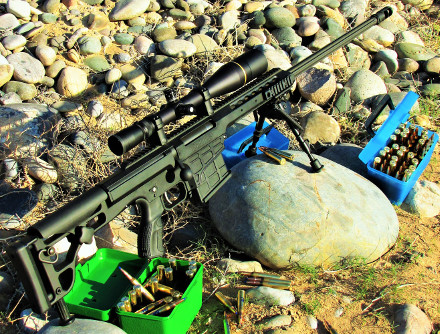
When Barrett, long since famous for their .50 BMG semi-auto rifle- the M82A1, announced a new from the ground-up, long range sniping rifle, tailored around the .338 Lapua Magnum cartridge, I knew I had to get one for testing. It took a while to arrive, but a bonus was that besides the standard 27” fluted barreled rifle, they also sent me one of the newly developed 20” heavy barreled versions, aimed at those wanting a more compact model for urban situations. While I'd already seen several articles which thoroughly described the design and innovations of the new rifle, writers limited themselves to just a couple boxes of factory ammunition, often only at 100 yards, with a few shots taken on steel plates at longer ranges.
Knowing that thousands of shooters world-wide are using various .338 Lapuas, I wanted to launch an effort to determine:
- How and if a shooter can feed his rifle on something less expensive than the very good factory ammunition,
- Could match ammunition performance be duplicated by a reloader, and
- Could hunting bullets also be loaded to produce accurate rounds for their big guns?
Leupold sent me two of their VX-3 8.5-25x50mm Long Range Target scopes with 30mm tubes. Their optical clarity was such that I was able to call, and see, most all of my shots at 300 yards. Performance was flawless during approximately 2,000 rounds of shooting. Armed with two new rifles, I gathered up lots of brass, a broad variety of bullets, and lots and lots of powders of various burning rates. Exhaustive testing would soon prove if some or all of my goals were achievable by the reloader, and just how accurate the new 98 Bravos could be.
Chapter 1: The Test Rifles
Click to LOAD DATA SHEET
Built on a 22.6 inch monolithic aluminum frame, the 98 Bravos incorporate an integral M1913 top rail, additionally having 4 inch rails on both sides at the front to accommodate various sighting and accessories options. The original offering had a heavy 27” match barrel, fluted past the handrail to reduce weight and hasten cooling. Its one in ten inch twist allows for stabilizing the increasingly popular, higher ballistic coefficient 300 grain match bullets. At the...
end of the barrel is an extremely efficient two-baffle design, 3” long muzzle brake. I found it to work very well, and unlike shooting most .50 BMG rifles so equipped, did not find it to excessively raise sound levels, or to produce shooter disturbing effects from the way it handles gas pressure.
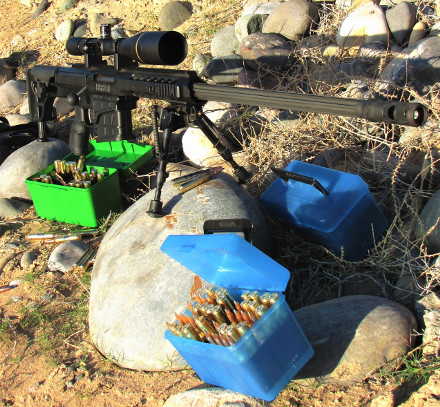
The frame is unique in that from the chamber rearward to the front of the cheek piece, it has an oversize bore for supporting the beefy nine-lug bolt in a two-piece synthetic sleeve assembly. The shorter sleeve serves to provide the loading and ejection ports right behind the front action locking recess. When the action is broken open, separating like the classic AR-15. When the bolt is removed, often the much longer rear sleeve also comes out with the bolt. With nine locking lugs, the bolt throw to open distance is very short, and the rear sleeve, though it stays in place, rotates slightly counterclockwise the very front and rear, in the rear synthetic sleeve.
The lower receiver is also aluminum and is pivoted and held in place at the top front of the magazine. Once the bolt handle is lifted, a receiver latch is depressed upwards, just a short distance behind the pistol grip (compatible with any AR-15 aftermarket pistol grips) and at the bottom. The front of the lower receiver has a well beveled recess to accept the 10-shot staggered magazine, robustly made of polymer and easy to strip for cleaning. Importantly, from the bench or in the field, it is very ergonomic to insert and remove a magazine with the ambidextrous release located at the front of the glovefriendly trigger guard.
Speaking of the trigger, it’s a very clean two-stage design, which predictably breaks at around 2-1/2 lbs. I found it predictable to take up the first stage, get my sights and breathing in check, and then pinch off the last portion such that I always had a perfect sight picture in my eye just as the rifle fired. The trigger allowed for minimal gun movement prior to the shot, making it easy to call the occasional pulled shot by the shooter. Yes, I sometimes do pull a shot, but it makes for greater ease in calling it on the target.
...
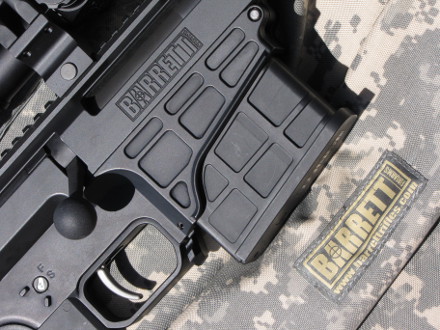
For shooting stability, a bipod comes standard with a height adjustable monopod at the rear. It would be better if the monopod had finer height adjustment increments, as often a lower hole would make the gun aim too high; a higher hole would result in it aiming much too low. I ended up with a very stable platform by putting a 2” thick sandbag under the monopod and squeezing it to adjust my point of aim up or down. Better still would be a threaded monopod to allow for fine adjustment with a side locking knob for securing in the desired position. Overall, the rifle is very impressive to look at, and Ialways had several people come up to me at the bench to see what I was shooting; its “wow factor” is very high. At around 13-1/2 lbs, the gun is fairly heavy but not excessively so.
The 20” heavy barreled non-fluted version was virtually the same feel as far as weight, but was noticeably easier to move around due to its shorter, more compact length. Initially, I thought a preference for one of the other would emerge, but after almost a thousand rounds through each one, I like them both. Of note also, is the extremely sturdy hard case each rifle comes with, cradled in rigid foam. All in all, a package infinitely more portable and convenient to wield on and off the bench, or in the field, than any .50 BMG I’ve ever tested.
Chapter 2: Reloading Components Tested
Generously, I was provided with 300 cases each from both Lapua and Hornady. As the water capacities of each brand were within less than one grain, as tested, I found no difference in resulting velocities or pressure with identical charges. The reputation of .338 Lapua brass as being very strong is well founded. Primer pockets remained tight even after 5 full-power loadings. Right from the start, Hornady told me that Federal 215 Large Rifle Magnum primers were found in their testing to give the best accuracy from the round, so that’s what I exclusively used. Over twenty powders were tested for accuracy and velocity, loaded under eighteen different bullets including both match and hunting styles, for a total of over 235...
bullet/powder combinations.
To save some time, I chose a representative bullet in each weight category, tried it with twenty powders, and then tested the other bullets of the same weight with only the most proven accurate powders. All told, almost 2,000 bullets were launched downrange. The precision and ergonomics of the Barretts actually made the task enjoyable, though the round count made it somewhat lengthy.
Why would I embark on such a massive project? With thousands of .338 Lapua rifles out in the field, why should each person have to go and develop accurate loads for his or her rifles? By investing the time and effort once early on, many shooters will reap the rewards of my undertaking. Besides, accurate rifles are fun to shoot!
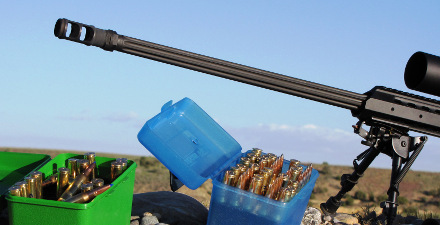
The twenty-two powders tested included- from Hodgdon: H4198, H322, H4895, Varget, H100V, H4350, H4831 SC, and H1000. IMR was represented with IMR 4198, 4895, 3031, 4007 SSC, 4350, 4831, and IMR 7828. Vihtavuori provided N133, N135, N530, N550, N560, N160, N170, and N570. Bullets not overly sensitive to the powder type are listed with up to nine final best performing powders. Seeing right off the bat how accurate the Bravos were, I set my maximum accuracy cutoff point fairly low. Why report a 1.3” combination, when there are plenty which deliver one-half to one inch 3- shot groups? After all, the Barrett’s are precision sniping rifles, and who would choose a less accurate load for use when many other loads can beat it, hands-down for accuracy?
Overall, the match bullets did very well, as did many of the hunting bullets. Since hunting bullets often cost less than match projectiles, I wanted to see if I could develop loads using them to approach the former’s accuracy.
Bullets tested included from Barnes: TTSXs in 160, 185, 225, and the new 265 TTSX specifically designed for the Lapua, as well as the also new 285 grain TSX. Hornady supplied the new 185 GMX expanding monolith, a very conventional 200-grain soft point, their 250 BTHP match, and also some early 285 grain soon-to-be announced BTHPs. Lapua generously sent me 250 grain match bullets in the LockBase and Scenar versions, as well as their long...
and pointy 300 grain Scenar. From Sierra, I tried 215 and 250 grain GameKing hunting bullets, as well as their MatchKings in 250 and 300 grains. Nosler provided the new 200 grain E-Tip expanding monolith and their 250 AccuBond.
My shooting sequence was as follows: First group out of a cold, clean barrel would be a sighter/fouler shot onto a practice target, then 3 rounds for grouping on my record targets. All rounds were loaded and fired shooting from the magazine, with not a failure to feed in the almost 2,000 rounds. That made me very happy.
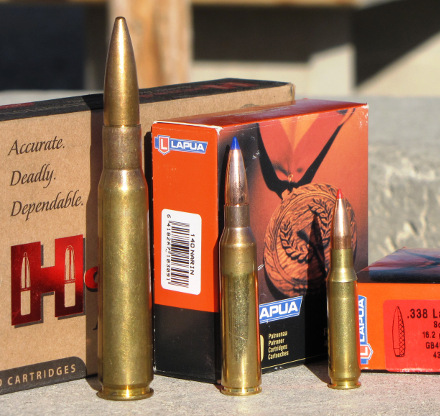
The stout barrels barely warmed to the event, so I fired another 3-shot combination, and then another 3, and then another 3… for thirteen total rounds, burning 70 to 100 grains of powder each shot. By that time, the barrels were more than warm, but not too hot to touch and hold on to. Then I would grab the other rifle and repeat this procedure. Round two saw me back with the first now cooled rifle for four groups of 3-shots, then finishing off with twelve rounds down the second rifle, which had also cooled by that point.
With 25 shots through each rifle, the barrels were cleaned with IOSSO synthetic brushes and Barnes CR-10 solvent. Twenty passes or so with the wetted brush, giving the cleaner 5-minutes or so to do its job, and then push two or three cotton patches down the barrel to make it nice and dry. Before taking a shot, I would hit the muzzle brake with aerosol carburetor/choke cleaner, and push a short rag sideways through both ports of the brake.
The match barrels proved very easy to clean. After twenty-five rounds, I was impressed with the lack of powder or jacket fouling shown on the white cotton patches. Even more impressive, towards the end of my shooting marathon, I fired in each gun over 75 rounds without cleaning to check for velocity comparisons. Much to my surprise, the first cotton patch, pushed down each barrel to absorb the solvent after doing its job, basically showed the same level of powder and bullet fouling as when shooting only twenty-five rounds for accuracy!
...
Chapter 3: Results and Recommendations
Generously, Barnes Bullets allowed me to travel to Utah and make use of the indoor 300 yard range in their new manufacturing facility. There, I could shoot without external variables to impact my results. This was done with almost 50 of the developed loads. I had no wind or rain, dust, burning sun or overcast conditions with which to contend. Gregg Sloan, from their lab, worked tirelessly with me for the two days of shooting, manning the chronograph, changing out targets, and putting up with my non-stop cadence of endless shooting.
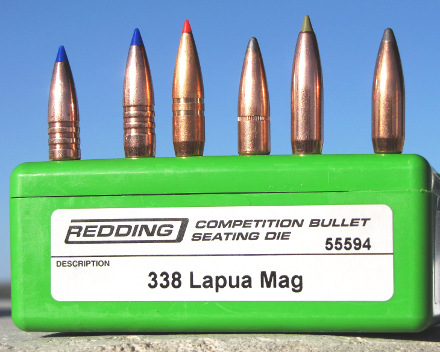
Shooting at 300 yards separated the acceptable loads from the really great ones, in a hurry. At first, I was not too excited with getting 1-1/4 ~ 2” groups, but then I realized that this was at 300 yards, not 100! Simple math proved to me that I was getting performance equal to 100 yard, 0.4 ~ 0.8”, if they had been shot that close.
I tried to develop lower recoiling loads using fast and medium burning rate powders that I usually work with in developing MELs (Moderate Effective Loads). Both IMR and H4895 did not do to well, nor did H322, though I had some success with IMR and H4198. Sixty-seven grains of H4198 drove the 160 Barnes TTSX to around 3,200 fps, delivering 2.8” groups at 300 yards. Better still was 62.1 grains of IMR 4198, and the Barnes 185 TTSX was good for around 2,900 fps and just under 2” groups at the same long distance. But the real low recoil performer was 63 grains of IMR 4198 under a traditional 200 grain Hornady soft point. It still gave around 2,800 and produced nice, round 1.4”, again, at 300 yards. With the 160 Barnes, 1.4” groups were obtained over 74 grains of N133, for 3,300 fps in the longer barrel. And over 3,660 fps resulted in 1.9” groups at 300 yards when pushed by 100.5 grains...
of N560.
The heavier 185 TTSX hit almost 3,250 from the long barrel, over 73.2 grains of N530, and shot into 1.34” at 300 yards. Powders that did well with the 185 Barnes were then tried under the new Hornady GMX bullet of the same weight. At 100 yards, 91.7 grains of IMR 7828 gave 2,900 to 3,100 fps, and 0.40”; 85.4 grains of H100V shot into 0.59” at a speed of 3,200 from the 27” barrel. With the 200 Hornady SP, it also did great over N530, H100V, H4350, and H4831 SC- hitting a speed of just over 3,300 from the long barrel while producing over 4,800 ft. lbs. The same-weight Nosler E-Tip matched that speed over 92.3 grains of N560, also shooting well at 0.71”.
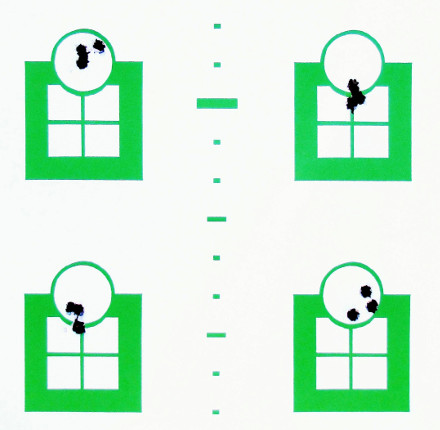
What were the best accuracy results with the 215 Sierra GameKing hunting bullet? It shot into 0.90 ~ 1.1”, using IMR 4007 SSC, H100V, IMR 4350, N550, or H4350, at speeds of 3,100 ~ 3,200. A great performance was turned in by the Barnes 225 grain TTSX bullet. Owner Randy Brooks told me this bullet is consistently the best shooting .338 caliber bullet they make. Most groups were around 5/8ths of an inch, with the best load featuring 80.3 grains of N550 for 0.36” groups at almost 3,050 fps. The fastest load used N570 for 3,200, producing 5,100 ft. lbs. with less than 1” groups.
For the traditional weight of 250 grains, my chosen bullet to test at 300 yards was the Lapua Scenar. The worst load produced 1.8”, 3-shot groups, while the best shot into a whisper over an inch- equivalent to shooting 0.32” groups at 100 yards. Nine powders did well with the Scenar with four of them matching or beating the 1.3” groups from Lapua factory ammo using that very same bullet. These four powders were IMR 4007 SSC, H4350, IMR 4831, and N570; a lower recoiling load, which shot into 1.5” at 300, used 70.3 grains of Varget, for 2,800 fps. Overall, using all nine of the test powders under the LockBase version, shot into 0.39 ~ 0.75” at 100 yards; I almost came to take its accuracy for granted.
Perplexing is a good word for the results of the 250 grain Hornady BTHP. In factory loads, I got 1.6” groups at 300 yards and a half-inch at 100. But most...
of my good reloads shot into an inch or less at the shorter distance. Hornady says they often find the bullet shoots the same at 300 yards as it does at 100, suggesting it’s just settling down at the longer range. Once I shot a 250 grain bullet in an 8mm magnum rifle which gave 1.25” groups at 100 yards and also produced the same size groups at 200 yards. I’ve often read that long for caliber bullets sometimes do not settle down for a while; perhaps just as a newly spinning top wobbles at first, then settles into a nice spinning posture.
The 250 grain Sierra MatchKing delivered 0.31 ~ 0.39” groups over IMR 4008 SSC, Varget, and IMR 7828. The worst of the nine powders shot for accuracy still produced 0.84”, 3-shot groups. Their GameKing hunting bullet of the same weight shot around 3/4″ with four powders, with N570 shooting into 0.67”. Nosler’s 250 AccuBond shot best at 0.91” over N550, or N570 producing almost 3,000 fps and 5,000 ft. lbs.
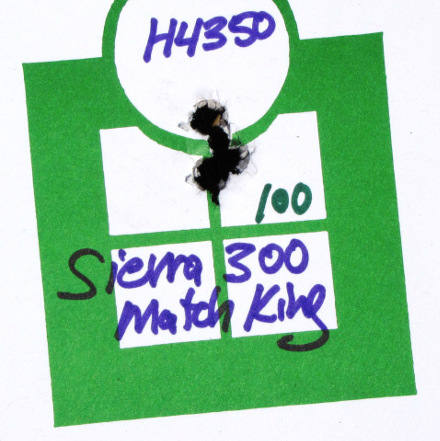
My “Oh my” group at 300 yards finally came when I shot the new 265 grain Barnes TTSX hunting bullet, at 2,750 when driven by IMR 7828. This is also the powder Barnes recommends as most accurate, but they used the SSC version. My first shot was just off center, to the left a hair, touching the vertical crosshair of my target. The second shot touched the first shot, landing just a little to the right. Gregg immediately spoke up “It’s touching your first shot!” I calmly looked back at him and stated, “Well then, I’ll have to put the third one right in there with the first two, won’t I?” My third shot did indeed touch my second shot. There was no open paper between any of the three shots, resulting in a measured 0.51” group, at 300 yards.
Almost as exciting was the 0.87” group, fired with the 285 grain TSX, over 75.9 grains of N160. Two shots touched, with the third just a short distance away. The 285 Hornady BTHP shot extremely well at 100 yards when loaded with H4831 SC, N550, IMR 7828, or N160. Groups ran from 0.47 ~ 0.66” with these four powders.
With the Lapua 300 Scenar over IMR 4350, 0.52” groups at 2,636 fps was my reward at 100 yards....
The same bullet at 300 yards shot into 0.87” when using N160, and 1.34” over N560, or as a factory load. A heavy bullet delight, the 300 Sierra MatchKing produced nice round groups of 0.43 ~ 0.55” at 100 when loaded over H4350, N160, IMR 4350, H4831 SC, or N560. That is the bullet used for the four consecutive tiny groups, shot on the target as shown in the one photo. Paper performance like that is what reloaders dream about. The fastest load was with N570, producing almost 2,800 fps, nearly 5,200 ft. lbs., and 0.59” three-shot groups at 100. A load like this would be effective in a hostile environment well past 1,000 yards.
Both the long and short barreled Bravos took turns firing tiny groups. That’s why the specific rifle used for the various loads is not specified in the data chart. It is already “busy” enough to read. They both had their share of under half-inch groups at 100 yards. Fear not- just select the one you like the best and start shooting. The shorter 20” barreled version only lost 150 to 230 fps over the longer 27” model. With PLENTY of horsepower on tap, intended targets will never know the difference.
Chapter 4: Summary
Sometimes I get so wrapped up in loading and shooting, loading and shooting, that I never realize until the end how well things have been going with my efforts. I number my targets, make note of which combination was shot, and what position on the paper. If the group seems good, then I circle the load on my data sheet, just as a brief reminder.
The fun comes when I sit down and start measuring things. My earlier stated goals were definitely realized, as far as handloading performance, which can readily be seen by the results of 125 listed loads. I know what a good group looks like, but it is exciting to measure tiny group after tiny group that were shot out of a large caliber magnum rifle, burning as much as 100 grains of powder, producing over 5,000 ft. lbs.
Looking back, I’m amazed at the number of great things about the Barretts. The superb, two-stage trigger allows for unprecedented control of the rounds sent downrange. The minimal fouling and easy cleaning properties of the match grade barrels are both significant. The wonderful ergonomics come to light, when after almost 2,000 shots, you don’t mind going to the range to shoot another 200. As a shooter, it's being able to experience flawless feeding...
from the magazines, again and again, while testing so many rounds.
The Barrett 98 Bravos are serious sniping rifles that come across as fine thoroughbreds, engineered for a very special purpose.